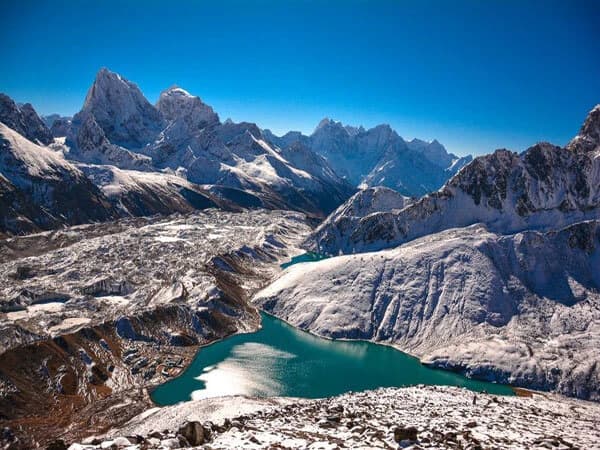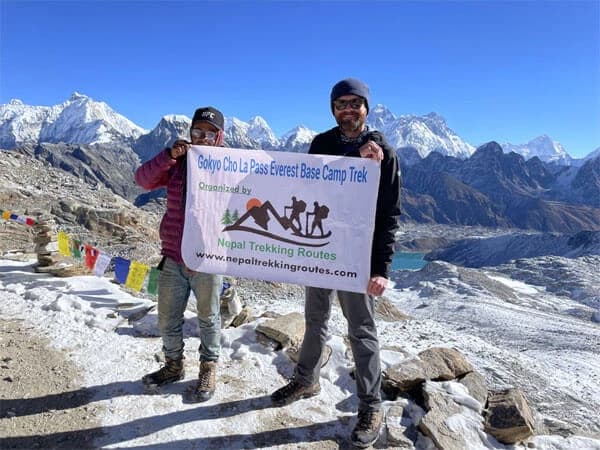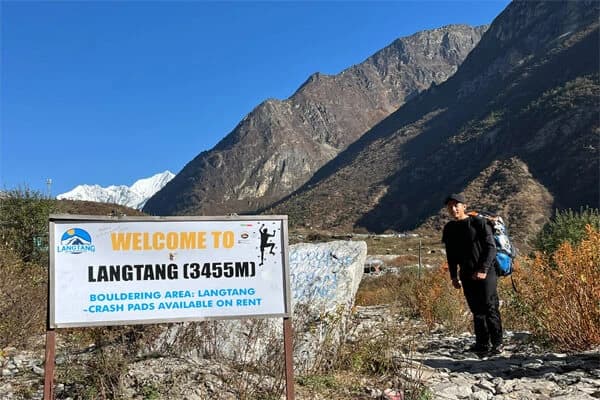Walking through the Himalayas and visiting Mount Everest is a dream for many people. The Everest Gokyo Cho La Pass Trek is among the most thrilling treks in Nepal. It transports you to stunning locations like as Everest Base Camp, Cho La Pass, and Gokyo Lakes. However, this journey is not simple. You will discover Gokyo Cho La Pass EBC Trek Difficulty in this blog. You will read about the difficult weather, lengthy walking days, and high mountains. In order to make the walk easier and more enjoyable, you will also learn how to prepare for it.
The trail is challenging, but it is also breathtaking. You pass through high mountains, snowy roads, and tiny communities. You can accomplish it if you are healthy, strong, and up for an adventure. We will also discuss hiring porters and guides to assist you. They facilitate and secure the journey. To find out more about the Gokyo Cho La Pass EBC Trek difficulty and preparation, continue reading if you are considering this trek.
Gokyo Cho La Pass EBC Trek Overview
The Everest Gokyo Cho La Pass Trek is one of the most stunning and daring treks in Everest region of Nepal. It runs through high snow-covered passes, picturesque valleys, and peaceful mountain communities. The Gokyo Lakes, a collection of azure lakes encircled by towering mountains, are among the primary attractions. Additionally, you have the opportunity to ascend Gokyo Ri, a viewpoint that offers breathtaking views of Mount Everest and other large peaks.
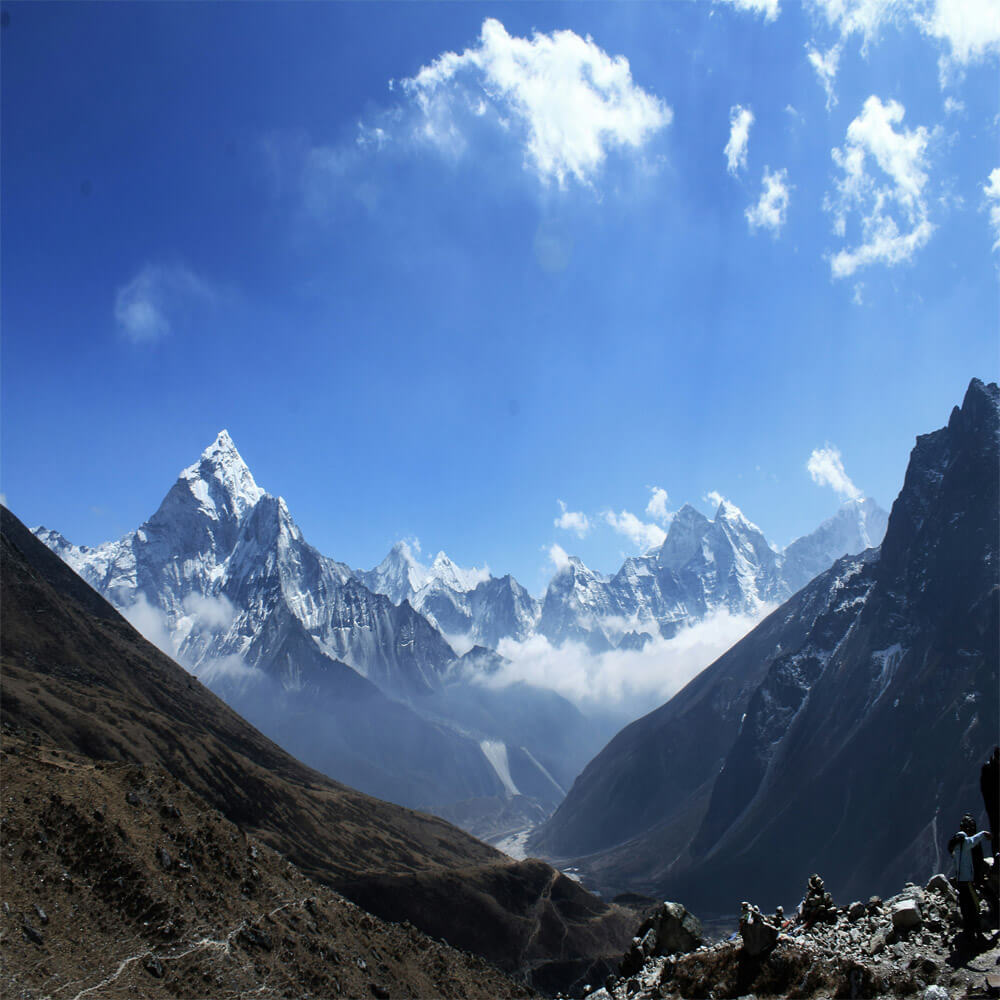
Following Gokyo, you will traverse the treacherous Cho La Pass, which links to the traditional Everest Base Camp trek route. This is an exciting yet rather challenging part. After that, you will proceed in the direction of Everest Base Camp, where mountain climbers start their ascent to the summit of the world. The greatest way to get a close-up look of Mount Everest is to climb Kala Patthar.
For those who are looking for an alternative to the standard Everest route, this journey is fantastic. You will spend 16 to 20 days there, sleeping at tea houses in the area. Because the track rises to 5,545 meters, it is crucial to walk gently and take breaks. The Everest Gokyo Cho La Pass Trek may be a transformative experience with the correct preparation and assistance.
Factors affecting Gokyo Ri Trek Difficulty
Despite its beauty, the Gokyo Ri Trek can be challenging at times. First of all, breathing becomes more difficult at high altitudes, particularly above 4,000 meters. Additionally, the trail has lengthy uphill treks and is steep in several places. Trekking in the mountains can be more challenging in cold weather and with strong winds. The path becomes more difficult if there is snow or ice on it. Walking for a long time (often 10–14 days) can also be exhausting. Trekking may feel difficult if you are not accustomed to it.
Daily Trekking Distance and Duration
One of the longest treks in the Everest region is the Everest Three Pass Trek. It transports you to stunning locations like as Everest Base Camp, Cho La Pass, Renjo La Pass, and Gokyo Lakes. It typically takes 16 to 20 days to complete this expedition. While some go slowly and take days off, others complete it more quickly.
On the trek, you walk for five to eight hours every day. Short treks are easier on certain days, while lengthy climbs are more difficult on others. For instance, because to the steep and high terrain, crossing Cho La Pass may require eight to nine hours of walking.
The walk covers roughly 130 to 160 kilometers (equivalent to 80 to 100 miles) in total. From Lukla, you will begin your journey by foot, passing through tiny towns, woods, rivers, and snow-capped mountains. To allow your body to adjust to the great altitude, you ascend gradually and cautiously.
It is crucial to keep in mind that this trek is not your average walk in the park. There are rough trails, peaks and valleys, and occasionally snow or ice. But you may relish each step if you have the correct attitude.
Acclimatization needs for high altitude treks
Acclimatization days are part of the trek, during which you remain stationary to allow your body to acclimate to the thin air. You can prevent altitude sickness, which can occur when you ascend too quickly, by taking these rest days.
Therefore, it is not a race, despite the lengthy travel and the time-consuming walking. You take breaks, walk leisurely, and take in the scenery. The trek will feel easier if you plan more in advance. Many individuals, including first-time trekkers, complete the trek with pride thanks to the help of guides and porters.
Altitude Challenges During Everest Gokyo Chola Pass Trek
The altitude is one of the main obstacles on the Everest Gokyo Cho La Pass Trek. You will reach some of the world's highest points on this expedition. You will traverse the 5,420-meter-high Cho La Pass on foot. That is higher than a lot of the world's mountains! Additionally, you will travel to Kala Patthar, Everest Base Camp, and Gokyo Ri, all of which are over 5,000 meters above sea level. The air gets thinner because it is so high. Your body will have less oxygen to breathe as a result.
Walking gets more difficult at elevations like these. Even a quick walk could leave you feeling exhausted. You can also have headaches or lightheadedness. We refer to this as altitude sickness.
Even experienced trekkers may sense it. The walk is not hurried because of this. To assist your body adjust to the high altitude, you take rest days and walk carefully. We refer to these days of rest as acclimatization days.
Altitude sickness risk in Gokyo trek
It is crucial to pay attention to your guide if you want to be safe at high elevations. You will learn when to move, when to relax, and when to drink water from your guide. Water consumption is highly beneficial. It keeps your body robust. While walking, you might also feel better by eating warm food and getting enough sleep.
You must notify your guide immediately if you begin to feel ill or extremely exhausted. They will be aware of what to do. They occasionally transport individuals to a lower location for rest. They feel better as a result. Your guide will constantly watch you closely because it can be risky to get too high too quickly.
The journey is more challenging due to the high altitude, but it is safe to complete with the correct preparation and a knowledgeable guide. Just be cautious, go slowly, and take in the breathtaking views of the surrounding mountains.
The Cho La Pass Crossing
The Everest Gokyo Cho La Pass Trek's most challenging section is the Cho La Pass. At 5,420 meters, the mountain pass is extremely high. Most folks have never been that high! Trekkers must ascend early in the morning to cross this pass. This is due to the fact that the weather in the highlands is subject to sudden changes. The snow may get slick and soft if you start late, which is dangerous.
The Cho La Pass trail is rough and steep. There is snow or perhaps ice in certain areas. You must move cautiously and gently. People occasionally use walking sticks to maintain their balance. Additionally, it is really cold here, particularly in the early morning. To keep comfortable and safe, trekkers need to wear warm clothing, gloves, and sturdy footwear. Because of the thin air, breathing is more difficult, and your body requires more energy.
Glacier crossing in Cho La Pass
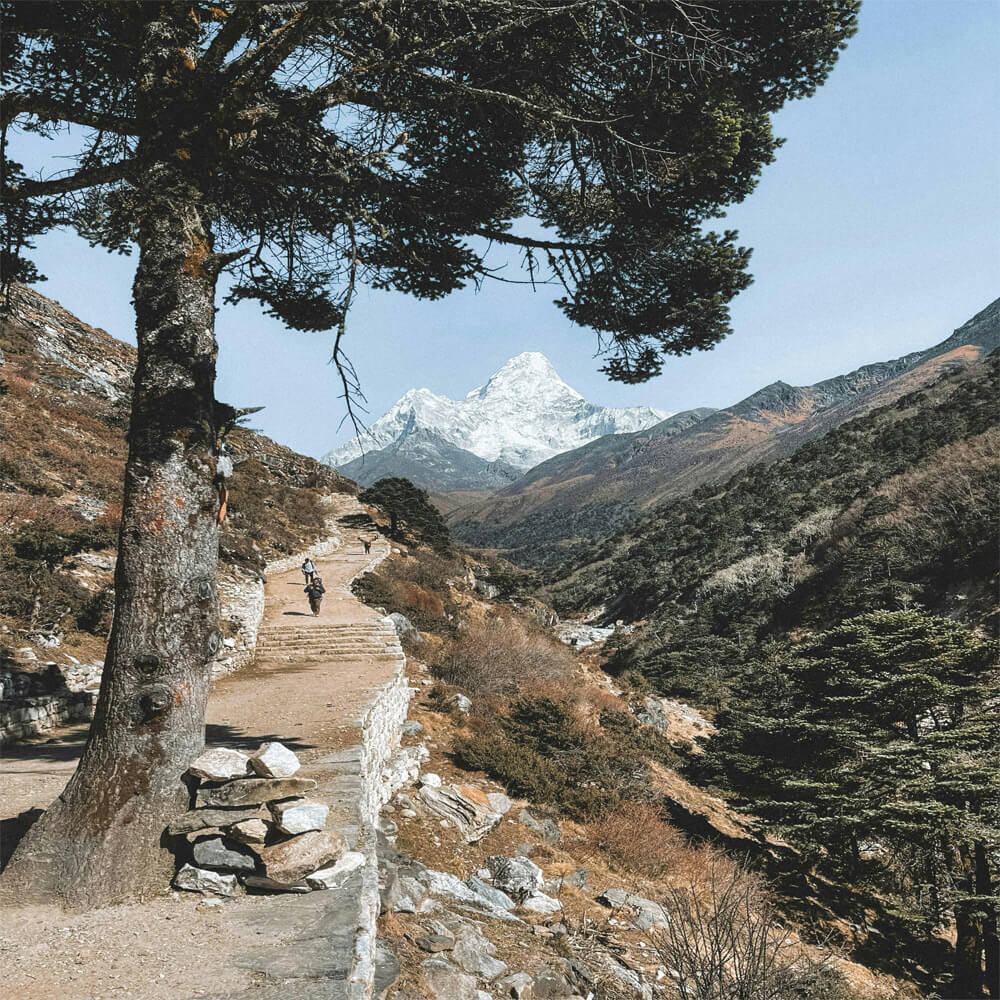
It takes more than just strength to cross the Cho La Pass. You must also exercise caution and bravery. The high altitude can make some people feel exhausted or lightheaded. For this reason, it is critical to take breaks and stay hydrated. Paying attention to your guide is also crucial. When things get tough, guides can aid because they are familiar with the route.
Weather and Terrain
Weather impact on Gokyo trek
On the Everest Gokyo Cho La Pass Trek, the weather can vary daily. While some days are sunny and warm, others may be chilly, overcast, or covered with snow. The temperature is warmer on the trek's lower elevations, such as Lukla or Namche. However, the temperature drops significantly, especially at night, when you ascend more into the mountains, such as at Gokyo or Cho La Pass.
The sky is typically clear and the trail is dry during the prime trekking seasons, which are spring (March to May) and autumn (September to November). Because of the safer and more consistent weather, these are the ideal seasons to visit. However, the weather can change quickly even during these months. Strong winds or snowfall might occur at any time. For this reason, trekkers should always have rain gear and warm clothing on hand.
Cho La Pass is extremely difficult to traverse during the winter months of December through February due to the extreme cold and snowfall. It rains a lot during the summer months of June through August. There could be landslides, and the trail becomes muddy and slick. Therefore, the majority of trekkers avoid going during these two seasons.
Trail conditions in Cho La Pass
Unlike a city road, the trekking track is not smooth. It has many highs and lows. There are sections of the trail that include steep slopes, uneven walkways, and slick stone stairs. You walk on snow, ice, and even over a glacier as you approach the Cho La Pass. This is a difficult section that requires additional attention.
It can be exhausting to walk on this type of terrain every day. It is crucial to walk slowly and take many breaks because of this. You can walk more safely if you use sturdy, well-made trekking shoes.
The road is difficult, but it is also quite beautiful. You view large snow-capped mountains, traverse wooden bridges, and walk alongside rivers. The trek is truly an adventure because of the rugged terrain.
Physical Fitness and Preparation
Physical fitness for Gokyo Cho La Pass trek
The trek to Everest Gokyo Cho La Pass is not a simple one. For many days, you will go up and down mountains and hills. Certain days are more difficult than others. Making your body robust before the walk is crucial because of this. This keeps you safe and allows you to enjoy the trip. You should be able to walk for several hours each day, but you do not have to be an elite athlete.
Walking big distances in the vicinity of your home is one of the best strategies to get ready. It is encouraging if you can walk up hills or stairs for five to six hours without feeling too exhausted.
Trekking once or twice a week will also be beneficial. To strengthen their legs, some people ride bicycles or go to the gym. It is preferable to do a small amount each day rather than a large amount all at once. At least a month or two prior to the expedition, begin your training. You will have more enjoyment if your body feels healthier.
Mental Preparation for Strenuous treks in Everest region
It takes more than just having strong legs to walk to the high mountains. It also comes down to mental toughness. It could be cold on some days. There may be difficult days. The path could be slippery or rocky, or you might feel exhausted. However, you will succeed if you maintain your composure and optimistic outlook. The high altitude can make people feel a little sick at times. You may walk more slowly than other people. It is alright. The most crucial thing is to follow your guide's instructions and proceed at your own speed. You will succeed if you have faith in yourself and never give up.
Even if it was their first time in the Himalayas, many people have finished this walk with the correct preparation and attitude. You too may experience this great adventure if you prepare properly!
Guide and Porter Support
Why Having a Guide Makes the Trek Easier and Safer
Having a guide on the Everest Gokyo Cho La Pass Trek is like having an experienced companion by your side. You do not have to worry about getting lost because a guide is quite familiar with the route. The trekking trail traverses through snow-covered passes, high mountains, rocky pathways, and woods. Knowing which way to go can be challenging at times, but your guide will always keep you on course.
Additionally, guides are aware of the ideal spots to rest, eat, and sleep. In the teahouses, they ensure that your food is warm and assist you in finding a clean room. Your guide will know what to do if the high altitude trekking makes you feel sick. They have received instruction in mountain safety and first aid. Your guide will make wise decisions to keep you safe in the event of an issue, such as bad weather or snow on the trail.
In addition to English, guides speak the local tongue. They facilitate conversations with villagers and teach you about their way of life. This adds enjoyment and significance to the walk.
How Porters Help You Enjoy the Trek More
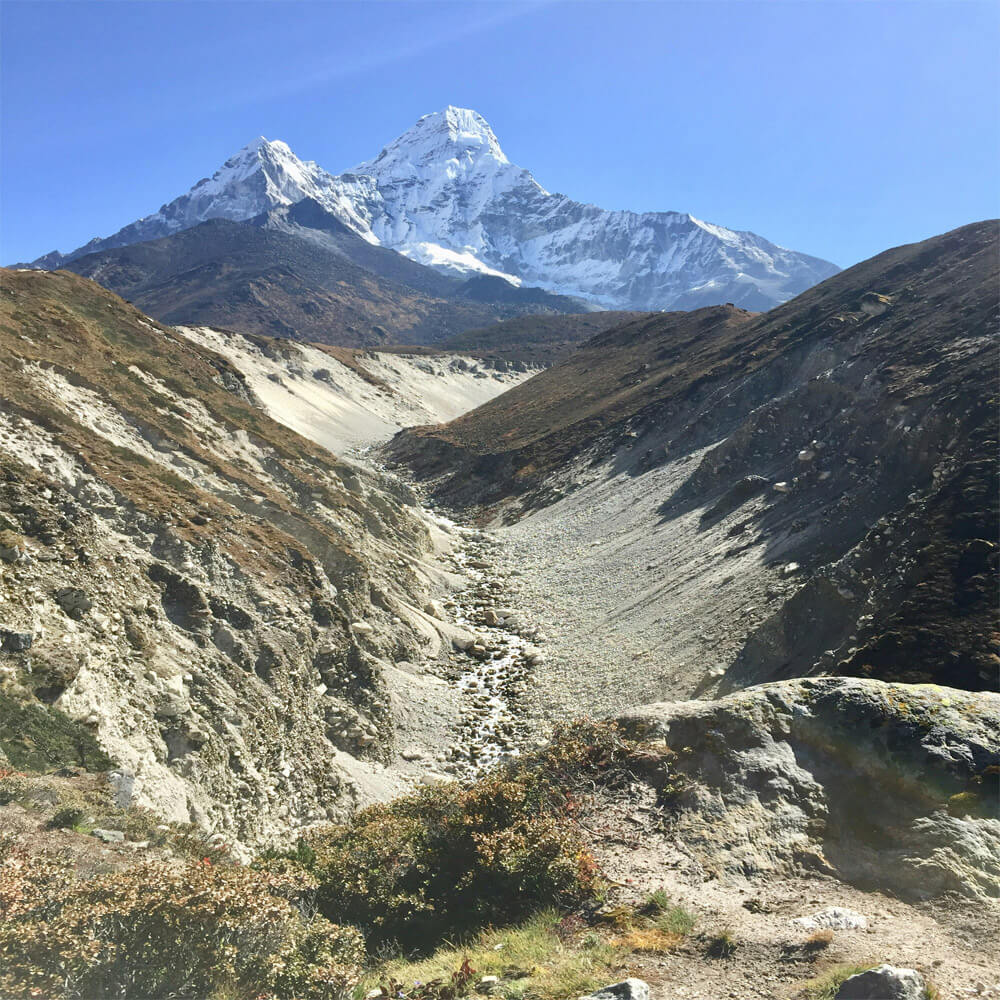
During the trek, porters strong assistants carry your bulky baggage. This eliminates the need for you to carry a heavy backpack as you walk. You only bring a tiny daypack that contains your jacket, water, and some snacks. It feels easier to walk without a heavy load, and you can take in the scenery more.
Porters typically walk in front of or behind you and carry up to 20 to 25 kg. They are from the mountain villages and are good-hearted and hardworking. Employing a porter is an excellent approach to support the neighborhood because it benefits their families as well.
You can concentrate on walking, breathing, and admiring the stunning mountains when you have a guide to lead you and a porter to carry your bag. When combined, they greatly increase the safety and enjoyment of your Everest Gokyo Cho La Pass journey.
Technical Level of Gokyo Trek
Since the Gokyo Trek is not a technical trek, you will not require any specialized climbing equipment, like as ropes or ice axes. The hike follows mountain trails. You will travel rocky trails, pass small bridges, and go up and down hills. The ascent to Gokyo Ri, a large hill of roughly 5,360 meters, is the most challenging phase. Although it is steep and exhausting, you can manage it if you walk slowly and take stops.
Some people experience fatigue or lightheadedness as they ascend because the air becomes thinner. For this reason, it is crucial to take things gradually, stay hydrated, and take frequent breaks.
Even beginners can complete this hike if they enjoy walking and are in good health. Many people need a porter and guide to assist them. A guide shows you the way and offers assistance as needed. To make walking easier, a porter handles your bulky bag.
The Gokyo Trekking is therefore not technical, yet being strenuous and exhausting. For those who enjoy walking and mountains, it is an amazing journey!
Gokyo EBC trek for beginners
The Gokyo Everest Base Camp (EBC) Trek is a strenuous and thrilling journey through Nepal's Himalayan mountains. It transports you to two unique locations: Everest Base Camp, where climbers begin their ascent of Mount Everest, and Gokyo Lakes. Although this trek is difficult, beginners can still complete it with the correct assistance and planning.
Over the course of 14 to 18 days, you will go up and down hills, cross rivers, and ascend tall mountains. Over 5,300 meters is the highest point, where breathing becomes more difficult due to the thin air. To aid in your body's adjustment, it is crucial to go cautiously and take days off.
Nepal Trekking Routes is a wise choice if you are a beginner. They ensure your safety and happiness, assist you in finding your way, and have porters carry your bags. Every day, you will eat warm food and sleep in tiny tea houses.
Even beginners can take pleasure in this incredible adventure with a little training, warm clothing, and a strong spirit. Yaks, prayer flags, snow-capped peaks, and amiable Sherpa people will all be visible. The memories will last a lifetime, and the vistas are breathtaking!
Conclusion: Gokyo Cho La Pass EBC Trek Difficulty
The Everest Gokyo Cho La Pass Trek is hard, but it is also very beautiful. You get to see tall mountains, blue lakes, glaciers, and small Sherpa villages. Some days are long and tiring. Climbing over the Cho La Pass is not easy. But if you are strong and take your time, you can do it.
If this is your first big trek, it is better to go with a guide. Our company, Nepal Trekking Routes has friendly guides who help you walk safely. Our guides plan your days, carry your bags with porters, and help if you feel sick. They also tell you about the local culture and nature.
Many claim that the trek is the greatest adventure of their lives, despite the fact that it is difficult. This walk is worthwhile if you plan beforehand, go slowly, and soak in the scenery. You will always remember it!
Some of Frequently Asked Question
What is the Everest Base Camp trek via Gokyo difficulty?
The Everest Base Camp trek via Gokyo is moderately to very difficult due to high altitude, steep trails, and crossing the icy Cho La Pass, requiring good fitness and proper acclimatization.
What is Difficulty level of Everest Three Passes trek?
The Everest Three Passes Trek is very difficult because of its high altitude, long trekking days, and steep mountain passes over 5,000 meters.
Is Trekking experience required for Gokyo EBC?
Trekking experience is not required for the Gokyo EBC trek, but it helps. Beginners can do it with good fitness, slow pace, proper acclimatization, and a trusted guide.
What is High passes trek in Nepal difficulty?
High passes trek in Nepal is very challenging due to steep climbs, long days, and high altitude over 5,000 meters, needing strong fitness and acclimatization.





